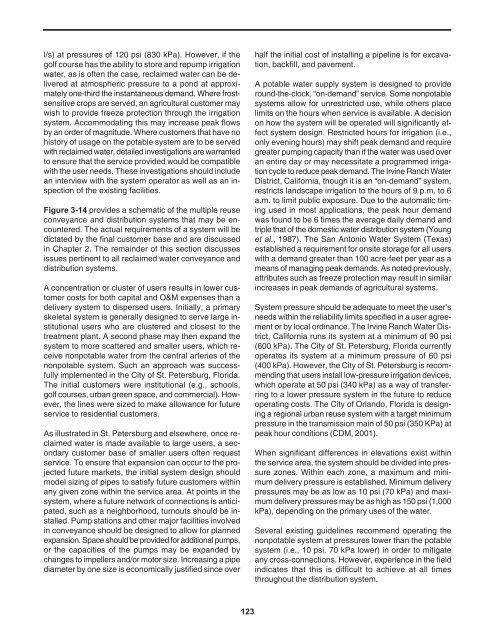o_19f3m1n7k170b14e9u0oqipgu4a.pdf
Create successful ePaper yourself
Turn your PDF publications into a flip-book with our unique Google optimized e-Paper software.
l/s) at pressures of 120 psi (830 kPa). However, if the<br />
golf course has the ability to store and repump irrigation<br />
water, as is often the case, reclaimed water can be delivered<br />
at atmospheric pressure to a pond at approximately<br />
one-third the instantaneous demand. Where frostsensitive<br />
crops are served, an agricultural customer may<br />
wish to provide freeze protection through the irrigation<br />
system. Accommodating this may increase peak flows<br />
by an order of magnitude. Where customers that have no<br />
history of usage on the potable system are to be served<br />
with reclaimed water, detailed investigations are warranted<br />
to ensure that the service provided would be compatible<br />
with the user needs. These investigations should include<br />
an interview with the system operator as well as an inspection<br />
of the existing facilities.<br />
Figure 3-14 provides a schematic of the multiple reuse<br />
conveyance and distribution systems that may be encountered.<br />
The actual requirements of a system will be<br />
dictated by the final customer base and are discussed<br />
in Chapter 2. The remainder of this section discusses<br />
issues pertinent to all reclaimed water conveyance and<br />
distribution systems.<br />
A concentration or cluster of users results in lower customer<br />
costs for both capital and O&M expenses than a<br />
delivery system to dispersed users. Initially, a primary<br />
skeletal system is generally designed to serve large institutional<br />
users who are clustered and closest to the<br />
treatment plant. A second phase may then expand the<br />
system to more scattered and smaller users, which receive<br />
nonpotable water from the central arteries of the<br />
nonpotable system. Such an approach was successfully<br />
implemented in the City of St. Petersburg, Florida.<br />
The initial customers were institutional (e.g., schools,<br />
golf courses, urban green space, and commercial). However,<br />
the lines were sized to make allowance for future<br />
service to residential customers.<br />
As illustrated in St. Petersburg and elsewhere, once reclaimed<br />
water is made available to large users, a secondary<br />
customer base of smaller users often request<br />
service. To ensure that expansion can occur to the projected<br />
future markets, the initial system design should<br />
model sizing of pipes to satisfy future customers within<br />
any given zone within the service area. At points in the<br />
system, where a future network of connections is anticipated,<br />
such as a neighborhood, turnouts should be installed.<br />
Pump stations and other major facilities involved<br />
in conveyance should be designed to allow for planned<br />
expansion. Space should be provided for additional pumps,<br />
or the capacities of the pumps may be expanded by<br />
changes to impellers and/or motor size. Increasing a pipe<br />
diameter by one size is economically justified since over<br />
half the initial cost of installing a pipeline is for excavation,<br />
backfill, and pavement.<br />
A potable water supply system is designed to provide<br />
round-the-clock, “on-demand” service. Some nonpotable<br />
systems allow for unrestricted use, while others place<br />
limits on the hours when service is available. A decision<br />
on how the system will be operated will significantly affect<br />
system design. Restricted hours for irrigation (i.e.,<br />
only evening hours) may shift peak demand and require<br />
greater pumping capacity than if the water was used over<br />
an entire day or may necessitate a programmed irrigation<br />
cycle to reduce peak demand. The Irvine Ranch Water<br />
District, California, though it is an “on-demand” system,<br />
restricts landscape irrigation to the hours of 9 p.m. to 6<br />
a.m. to limit public exposure. Due to the automatic timing<br />
used in most applications, the peak hour demand<br />
was found to be 6 times the average daily demand and<br />
triple that of the domestic water distribution system (Young<br />
et al., 1987). The San Antonio Water System (Texas)<br />
established a requirement for onsite storage for all users<br />
with a demand greater than 100 acre-feet per year as a<br />
means of managing peak demands. As noted previously,<br />
attributes such as freeze protection may result in similar<br />
increases in peak demands of agricultural systems.<br />
System pressure should be adequate to meet the user’s<br />
needs within the reliability limits specified in a user agreement<br />
or by local ordinance. The Irvine Ranch Water District,<br />
California runs its system at a minimum of 90 psi<br />
(600 kPa). The City of St. Petersburg, Florida currently<br />
operates its system at a minimum pressure of 60 psi<br />
(400 kPa). However, the City of St. Petersburg is recommending<br />
that users install low-pressure irrigation devices,<br />
which operate at 50 psi (340 kPa) as a way of transferring<br />
to a lower pressure system in the future to reduce<br />
operating costs. The City of Orlando, Florida is designing<br />
a regional urban reuse system with a target minimum<br />
pressure in the transmission main of 50 psi (350 KPa) at<br />
peak hour conditions (CDM, 2001).<br />
When significant differences in elevations exist within<br />
the service area, the system should be divided into pressure<br />
zones. Within each zone, a maximum and minimum<br />
delivery pressure is established. Minimum delivery<br />
pressures may be as low as 10 psi (70 kPa) and maximum<br />
delivery pressures may be as high as 150 psi (1,000<br />
kPa), depending on the primary uses of the water.<br />
Several existing guidelines recommend operating the<br />
nonpotable system at pressures lower than the potable<br />
system (i.e., 10 psi, 70 kPa lower) in order to mitigate<br />
any cross-connections. However, experience in the field<br />
indicates that this is difficult to achieve at all times<br />
throughout the distribution system.<br />
123



